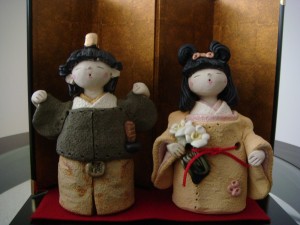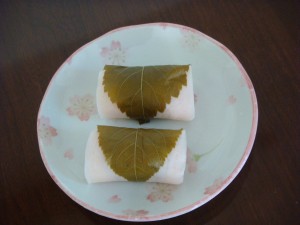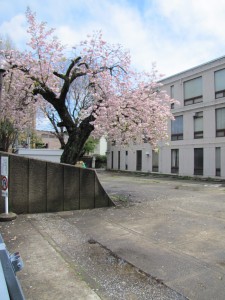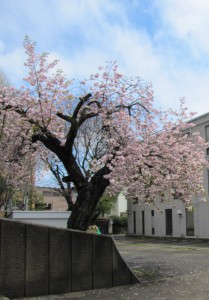One year after I moved to Japan I started taking shodo lessons (Japanese calligraphy) with Michelle. I lasted for a few months until I decided I was finished with this cultural experience. I wasn’t good at it. Several of my friends have taken sumie painting lessons from the same teacher and they are good. This week a friend brought me this painting of persimmons done by the sensei (teacher). He is very talented and I think there is just a touch of whimsy in his work. He probably wouldn’t like to hear that since he is very serious about his art.
Category: Seasons (Page 3 of 3)
Since I saw the Hina Matsuri dolls my first year in Japan, I have wanted a set. If you know anything about me you will know that I would not want the huge seven tired set that can be seen this time of year in Japan. Hina Matsuri takes place on March 3 and celebrates Girl’s Day. This is the day that families pray for the health and prosperity of their girls. It helps to ensure that they grow up healthy and beautiful. A girl’s first Hina Matsuri is called her hatsu-zekku. On her first Girl’s Day it is very popular for her grandparents to buy her a set of dolls to display:

The display can have up to seven tiers arranged with dolls and furniture. The top tier always has the emperor and empress displayed with a gilded screen behind them. Most families display their dolls beginning in mid-February and put them away immediately after Hina Matsuri is over. They believe that families who are slow to put away their dolls will have a hard time marrying off their daughters.
There is a new little shop near my house that sells traditional Japanese gifts and crafts from all over Japan. This is what I found:

It’s the small set I have been looking for. They are made of wood and I love the hand painted detail. The tiny emperor is just 4 inches tall and the empress is just 3 inches. I also felt good helping this new little shop.
Last Monday, when I returned from the US I had a beautiful gift waiting for me. My French friends Frederic, Karine, Zoe and Aimie gave me this set as a thank you gift for keeping Zoe while Karine was in the hospital giving birth to Aimie.

It was totally unexpected, but very much appreciated. It is so beautiful and unique. I have never seen a set like this. It’s such a wonderful gift and it will always remind me of wonderful friends and the fun that I had with my little friend Zoe.
There are special treats on Girl’s Day. Shops stock feminine looking sweets in pastel colors. Yesterday, I decided to try some traditional Japanese sweets. They are delicate pink pancakes filled with red bean paste, rolled and wrapped in a leaf that has bean soaked in something slightly salty. The salty taste was a nice contrast to the sweet red bean paste.
Happy Hina Matsuri!

 One thing the Japanese are very proud of is that their country has four seasons. I think that some of them actually believe that Japan is the only place in the world that does. Japanese friends have looked at me in disbelief when I have tried to explain that Utah, where I grew up, has four seasons,too. The Japanese people love nature and observing the changing of the seasons and it is fun to take part. This past weekend, the sakura, cherry blossoms, were in full bloom. The sakura is considered the national flower of Japan. There are over 400 varieties of cherry trees in Japan. Japanese
One thing the Japanese are very proud of is that their country has four seasons. I think that some of them actually believe that Japan is the only place in the world that does. Japanese friends have looked at me in disbelief when I have tried to explain that Utah, where I grew up, has four seasons,too. The Japanese people love nature and observing the changing of the seasons and it is fun to take part. This past weekend, the sakura, cherry blossoms, were in full bloom. The sakura is considered the national flower of Japan. There are over 400 varieties of cherry trees in Japan. Japanese  sakura do not yield fruit like other cherry trees. Hanami (cherry blossom viewing) has come to represent gathering under the sakura trees with friends and celebrating the beauty of the blossoms at their transient peak. First, a tarp is spread on the ground to mark a group’s territory. Often, low tables and cushions are brought in. The party goers sit under the cherry blossoms to eat and drink sake and beer.
sakura do not yield fruit like other cherry trees. Hanami (cherry blossom viewing) has come to represent gathering under the sakura trees with friends and celebrating the beauty of the blossoms at their transient peak. First, a tarp is spread on the ground to mark a group’s territory. Often, low tables and cushions are brought in. The party goers sit under the cherry blossoms to eat and drink sake and beer.
Most of Tokyo’s residents were out viewing the cherry blossoms on Saturday. I didn’t arrive back in Japan, from the US, until after dark Saturday night. I had hoped to get out for a walk Sunday, but it rained Sunday and Monday. Today, I was finally able to walk to my favorite place to view cherry blossoms, Aoyama Cemetery. I like Aoyama because the trees line both sides of the main street and form a beautiful canopy to stroll under. It’s peaceful and less crowded than other locations making it easier to snap a photo without a thousand people in it. So you see, once again I blog about the seasons.
blossoms, Aoyama Cemetery. I like Aoyama because the trees line both sides of the main street and form a beautiful canopy to stroll under. It’s peaceful and less crowded than other locations making it easier to snap a photo without a thousand people in it. So you see, once again I blog about the seasons.
Saturday, March 1, the Todaiji Temple in Nara was all lit up during the annual Omizutori festival. This festival marks the beginning of spring. It would have been cool to be there, but Nara is near Kyoto and definitely not near here. I don’t really need the priests in Nara to tell me that spring is here the ume (plum) blossoms and warmer weather tell me that. However, I did first notice the ume a few weeks ago when I went for a walk in the park during a snow storm. The bright pink blossoms were quite a contrast to the snow. I really need to get out and have a more exciting life. The weather and seasonal changes in the park are quite boring. I need to get some pictures of dogs in strollers or something!!!! Japan really isn’t as boring as I make it seem. So it’s 2 pm and I am off with my camera to find something interesting to blog about and besides I still need some exercise today!
The bright pink blossoms were quite a contrast to the snow. I really need to get out and have a more exciting life. The weather and seasonal changes in the park are quite boring. I need to get some pictures of dogs in strollers or something!!!! Japan really isn’t as boring as I make it seem. So it’s 2 pm and I am off with my camera to find something interesting to blog about and besides I still need some exercise today!





